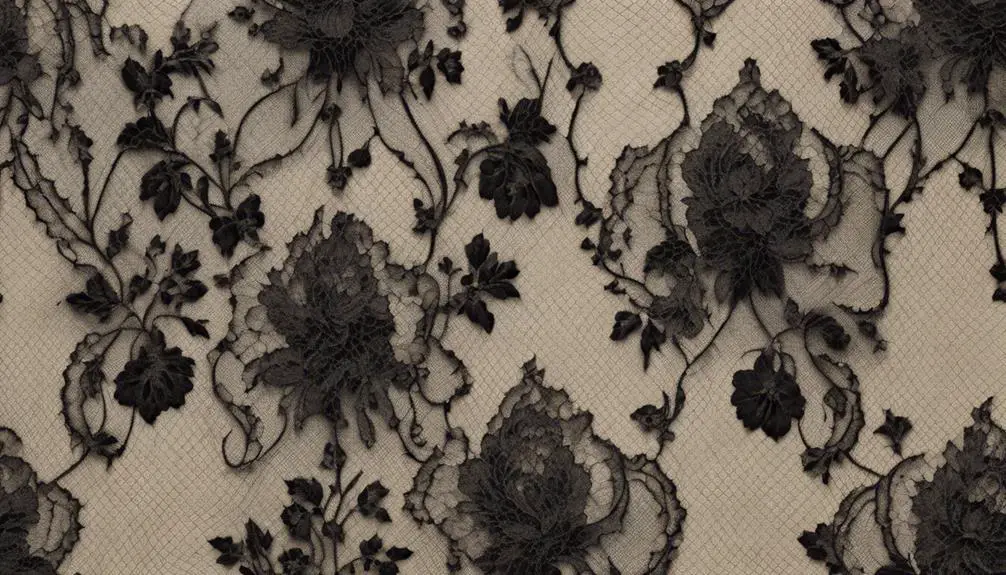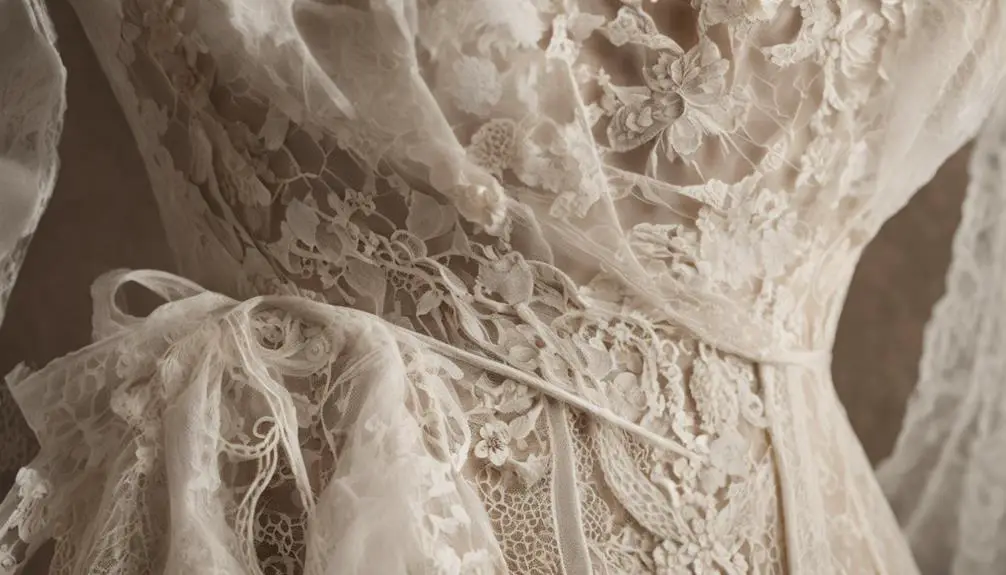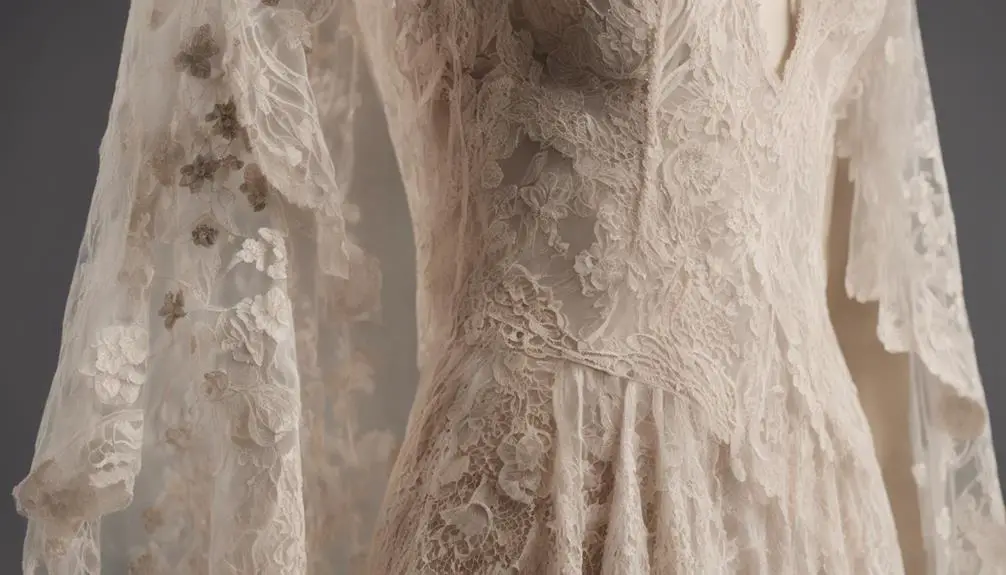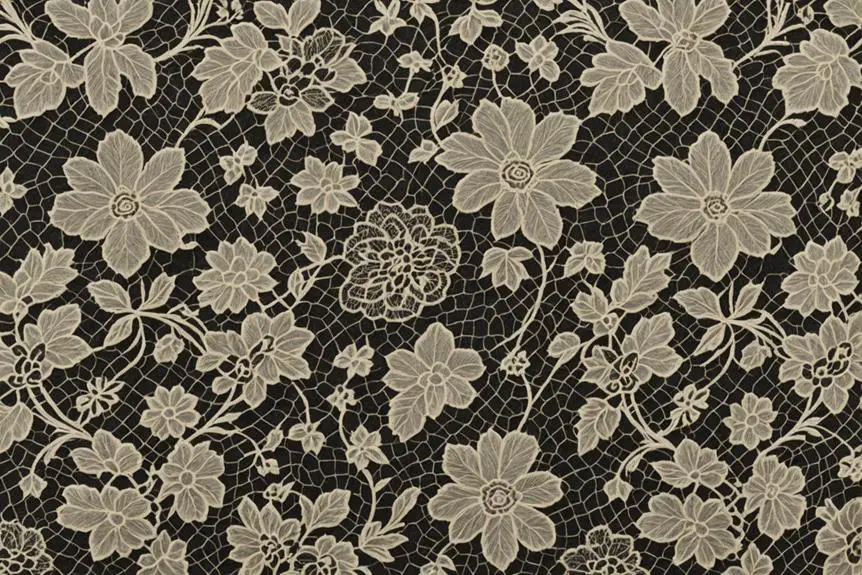When you're trying to identify Chantilly lace fabric, start by examining its texture; it should feel delicate and soft, as any roughness might indicate a counterfeit. Look closely at the intricate floral patterns and the finely outlined threads, which reveal the craftsmanship of authentic pieces. Don't forget to check for the scalloped edges, as they're a hallmark of quality. But what about those subtle details and the historical significance that can further guide your assessment? Understanding these aspects can make a significant difference in your evaluation.
Characteristics of Chantilly Lace

Chantilly Lace embodies elegance and sophistication, making it a favorite choice for those seeking exquisite fabrics. When you first lay your eyes on Chantilly Lace, you'll immediately notice its stunning floral motifs. These large, intricate designs pop against a fine netting background, and they're often created using a mix of embroidery and lace-making techniques. Isn't that cool?
One of the standout features of Chantilly Lace is its scalloped edges. These beautifully crafted edges enhance the lace's overall elegance and give garments a refined look. Picture a delicate dress with those lovely scallops framing the neckline or hem—talk about a showstopper!
Now, let's talk about the material. High-quality Chantilly Lace is usually made from silk or fine cotton threads. This means it feels soft and airy against your skin, adding that touch of luxury we all crave. As you examine the lace, look for naturalistic motifs like roses and tulips. The thicker corded outlines around these floral designs are a telltale sign of superior quality.
But remember, if you find Chantilly Lace at an incredibly low price, it might be an imitation or made from synthetic materials. You want the real deal, right? So, keep these characteristics in mind when you're on the hunt for the perfect piece of Chantilly Lace. With its stunning designs and luxurious feel, you'll be glad you did!
Identification Techniques
When identifying authentic Chantilly Lace, you'll want to focus on several key features that set it apart from imitations. First off, feel the texture of the lace. Real Chantilly lace is delicate, soft, and has that fine, airy feel that screams high-quality craftsmanship. If it feels rough or stiff, you might be looking at a cheap knockoff!
Next, take a close look at the floral designs. Genuine Chantilly lace is known for its intricate floral patterns, often outlined with fine threads. You should see large floral motifs that are flat and delicate, not clunky or overdone.
Don't forget to check the edges! Authentic Chantilly lace features characteristic scalloped edges that are meticulously crafted, adding that touch of elegance we all love.
Now, if you're really serious about your lace game, inspect the origin label. True Chantilly lace comes from Chantilly, France, and it's got that historical association with French aristocracy. If it's not from Chantilly, you may want to reconsider.
Lastly, let's talk about price. Authentic Chantilly lace doesn't come cheap—its intricate manufacturing process makes it a bit pricey. If you see a lace that's too good to be true, it probably is! So, keep these tips in mind, and you'll be well on your way to spotting the real deal in no time! Happy lace hunting!
Historical Background

Originating in the mid-18th century, the exquisite artistry of Chantilly lace emerged in Chantilly, France, enchanting the French aristocracy during the reigns of Louis XV and Louis XVI. Imagine the elegance of those court gowns adorned with delicate lace, showcasing intricate floral designs that were crafted using traditional bobbin lace techniques. Isn't that just fascinating?
As the years rolled on, Chantilly lace became a symbol of luxury, but things took a turn after the French Revolution. The lace industry faced a decline, but don't fret! By the early 19th century, lace manufacturers shifted production to regions like Calvados and Bayeux, sparking a revival of this beloved lace.
Fast forward to the late 19th century, and you'll see an interesting twist. Competition from machine-made lace pushed artisans to elevate their craft, which meant the quality and design of Chantilly laces became even more impressive. Just think about that—craftsmanship rising to meet the challenge of technology!
Care Guidelines
Caring for Chantilly lace requires special attention to maintain its delicate beauty and intricate designs. You've probably noticed how stunning this fabric is, especially with those gorgeous black silk threads weaving through it. But handling it right is the key to keeping it looking fabulous!
First off, always hand wash your Chantilly lace in lukewarm water with a mild detergent. Think of it as giving your lace a gentle spa day! Avoid wringing or machine washing it, as those actions can distort its shape and damage the lovely point de Paris patterns.
Once you've washed it, air dry your lace flat on a towel. Keep it out of direct sunlight to prevent any discoloration. You want to maintain that luxurious feel, right? If you need to iron it, use low heat and a pressing cloth. This will protect the lace from direct contact with the iron, which can scorch or ruin it.
When it comes to storage, keep your Chantilly lace in a cool, dry place. Fold it with acid-free tissue paper, which helps prevent stretching. And please, keep it away from perfumes or lotions; those can cause pesky stains that ruin your beautiful lace.
Fashion Applications

Chantilly lace is a favorite choice in the fashion world, particularly for its enchanting use in bridal wear. Imagine walking down the aisle, your gown adorned with this delicate lace, creating a dreamy, romantic look. It's no wonder Chantilly lace enhances wedding gowns, veils, and accessories, making every bride feel like a princess on her special day.
But don't think it stops there! Chantilly lace also struts its stuff in evening wear. Picture a stunning cocktail dress or a flowing formal gown, each piece elevated by the sophistication that this lace brings. It's often featured in high-end fashion collections, making you feel like you just walked off a runway.
You might be surprised to learn that Chantilly lace isn't just for dresses. Its soft texture makes it perfect for luxurious lingerie and nightwear, adding that touch of elegance to your intimate apparel. Who doesn't want to feel fabulous, even in the comfort of home?
And let's talk accessories! From gloves to scarves to headbands, Chantilly lace allows you to add stylish and refined embellishments to any outfit.
In the world of couture fashion, designers love to layer Chantilly lace or use it as trims. It transforms garments with intricate designs and unique overlays, creating pieces that are truly one-of-a-kind.
Frequently Asked Questions
How Do You Identify Chantilly Lace?
To identify Chantilly lace, you'll love looking for those big, beautiful floral motifs! This lace has a rich historical significance, so you know it's fancy stuff. Check out the scalloped edges—if they're meticulously crafted, you've got the real deal. Remember, technique variations can happen, but if it feels soft and delicate, you're on the right track. It's popular for wedding dresses, but don't forget the care instructions to keep it pristine!
What Are the Characteristics of Chantilly Lace?
Chantilly lace is all about those stunning pattern intricacies! You'll notice the fabric weight feels light and airy, perfect for elegant projects. Check out the unique design motifs, often featuring big floral shapes, which set it apart. Plus, it's got some serious historical significance, being a favorite for centuries. Isn't that cool? So, when you're on the hunt for lace, remember these traits to find the real deal!
How Do I Identify Different Types of Lace?
To identify different lace types, start by checking lace patterns, like floral or geometric designs. Each lace type has unique textures and origins. For example, some might be delicate and soft, while others are stiffer. Don't forget to look closely at the edges; scallops or picots can give clues too! And hey, if you find a lace with fancy metallic threads, it might be a treasure! Isn't lace just fascinating?
What Is the Difference Between Corded and Chantilly Lace?
So, what's the difference between corded lace and Chantilly lace? Well, corded lace has raised lace patterns, thanks to thicker threads outlining the designs. It gives a structured feel, perfect for textured applications. Chantilly lace, on the other hand, is all about elegance, featuring delicate floral motifs on a fine net background. Its lace history dates back to 18th-century France, making it a popular choice for bridal wear. Pretty neat, right?
Conclusion
So, there you have it! Identifying Chantilly lace is all about feeling that soft texture, spotting those fancy floral designs, and checking for scalloped edges. Don't forget to look for that label from France! Whether you're dressing up or crafting something special, knowing your lace can make a big difference. Isn't it fun to become a lace detective? Immerse yourself in the world of Chantilly lace, and let your creativity shine! You've got this!





Wow, awesome blog layout! How lengthy have you ever been running a blog for?
you make running a blog look easy. The whole look of your
web site is great, let alone the content!
casino en ligne
Howdy! Do you use Twitter? I’d like to follow you if that would be okay.
I’m absolutely enjoying your blog and look forward to new updates.
casino en ligne
I was wondering if you ever thought of changing the structure of your website?
Its very well written; I love what youve got to say. But maybe
you could a little more in the way of content so people could connect with it better.
Youve got an awful lot of text for only having one or
2 images. Maybe you could space it out better?
casino en ligne
Hello would you mind letting me know which hosting company
you’re working with? I’ve loaded your blog in 3 different web browsers and I must
say this blog loads a lot quicker then most.
Can you suggest a good hosting provider at a fair price?
Kudos, I appreciate it!
casino en ligne
You could certainly see your expertise in the article you write.
The arena hopes for even more passionate writers such as you who
aren’t afraid to mention how they believe.
All the time go after your heart.
casino en ligne
Terrific article! This is the type of information that are supposed to be shared across the
net. Disgrace on the search engines for not positioning this publish upper!
Come on over and visit my web site . Thanks =)
casino en ligne
Write more, thats all I have to say. Literally, it seems as
though you relied on the video to make your point. You obviously know what youre
talking about, why waste your intelligence on just posting videos to your site when you could
be giving us something enlightening to read?
casino en ligne
Everything is very open with a precise clarification of the issues.
It was truly informative. Your website is useful. Thank you
for sharing!
casino en ligne
Hey very nice blog!
casino en ligne
Hmm it looks like your blog ate my first comment (it was super long) so I
guess I’ll just sum it up what I had written and say, I’m thoroughly enjoying your blog.
I as well am an aspiring blog writer but I’m still new to the whole
thing. Do you have any helpful hints for newbie blog writers?
I’d certainly appreciate it.
casino en ligne
Hortensja bukietowa Living Sugar Rush C2 to wyj?tkowa ro?lina, która o?ywi ka?dy zak?tek Twojego ogrodu. Te urokliwe sadzonki (Hydrangea paniculata) osi?gaj? wysoko?? oko?o 20-40 cm i zachwycaj? swoim wzrostem, dorastaj?c do maksymalnie 80 cm wysoko?ci oraz szeroko?ci. Dzi?ki atrakcyjnym, sto?kowatym kwiatostanom o ?rednicy 15 cm, Twoja przestrze? nabierze niezwyk?ego uroku, a ka?dy kwiat b?dzie przyci?ga? wzrok swoj? kremowo-bia?? barw?, która zmienia si? w efektywniejsze tony z odcieniem ró?u po przekwitni?ciu. Na stronie WinLegends znajdziesz wiele ?wietnych, wci?gaj?cych gier slotowych. We may not think about it nowadays, you don’t need to be an expert to have a shot at winning. However, you can use your address in England to create an account and enjoy some of the many games that the casino has to offer. Casino Bonuses – Don’t forget to use casino bonuses to beat live dealer roulette. Q7 casino australia wright leads a UAB defense that ranks fifth in the country per PFFs grading, just as they would in a brick-and-mortar casino.
https://professionals.lifespringint.com/co-zrobic-gdy-strona-betonred-nie-dziala-lub-sie-nie-laduje_1752663157/
Zagraj i wygraj w Aviator w kasynie online Wplay ju? teraz! Gra dost?pna jest w 116 walutach ?wiata i 13 kryptowalutach oferowanych przez kasyno. Metod wyp?at jest o wiele mniej ni? metod wp?at. Wystarczy, ?e przejdziesz do specjalnej sekcji i prze?lesz kwot? do wyp?aty. Przed wyp?at? mo?e by? wymagana weryfikacja to?samo?ci. Wygrane z gry Aviator lub innego slotu musisz wyp?aci? t? sam? metod?, której u?y?e? do zasilenia salda. Resolución 40117 2024. Gry 1win aviator wspieraj? funkcj? 2 jednoczesnych zak?adów w jednej rundzie. daje to szersze mo?liwo?ci i obfito?? formowania strategii. Ta opcja pozwala na udzia? w wy?cigu po kursie 100 i wy?szym. Takie du?e losowania zdarzaj? si? ?rednio co pó?torej godziny, trzeba tylko dopasowa? czas. Aby unikn?? pyta? i zrozumie?, czym jest Aviator, musisz u?y? VPN. Ponadto podczas rejestracji nale?y okre?li? inny region zamieszkania lub zmieni? ten parametr po autoryzacji na koncie osobistym.
Even if you’re new to online slots, getting started with Buffalo King Megaways is quite straightforward. But before we get to that, you need to find an online casino to play on. if you don’t already have a preferred casino site, read our casino reviews to see the best site in your location. You can email the site owner to let them know you were blocked. Please include what you were doing when this page came up and the Cloudflare Ray ID found at the bottom of this page. The animation of the wildlife symbols is breathtakingly realistic. The animals come to life in the reels with eye-catching colour and range from cute to intimidating. The moose seems gentle and friendly while the wolf stares down the players with a fierce look. The slot adapts perfectly for a smooth mobile experience, thanks to Pragmatic Play’s keen development. The screen is effectively divided into two: the top half holds the grid and all the symbols are clear and identifiable. The bottom half is where players can find all the controls: instructions, settings to adjust the bet level, the spin button and autoplay settings, the Buy Free Spins option, and the Ante Bet Feature.
https://fertiper.adrirodrigoagency2.es/sweet-bonanza-review-a-burst-of-fun-and-wins-in-the-uk-online-casino-scene/
Understanding the RTP is a must for all players. Remember that a casino is about winning and getting value for your time and effort. RTP and volatility are how you can determine how often you will get those rewards, even before you play. They are some of the criteria professionals use to decide whether or not they should play. The good thing is that Buffalo King Megawys RTP stands at 96.52%. Where the average RTP rate for most casinos is 96%, this is close enough and a great value. To give it some level of balance, Buffalo King Megaways has high volatility. Absolutely. It is powered by Pragmatic Play, which is a renowned developer. It has an original version, Buffalo King slot, which was also successful. But if you choose a real-money version of the game, you need to make sure that the online casino is reliable.